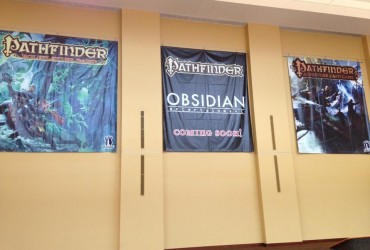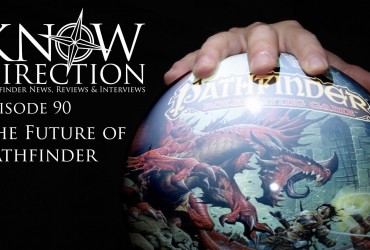Welcome to Guidance, Private Sanctuary’s source for tips and techniques for the Pathfinder Roleplaying Game, written by Everyman Gamer Alexander Augunas. Today, we’re going to be talking about My Little Pony: Friendship is Magic.
I swear that my next Algalon Paradigm was going to be the Order of the Stick! It really was!
I have a buddy who is fairly into My Little Pony. I didn’t quite “get” the following that this show has with teenage and adult men (and honestly, I still don’t “get” it) but when someone recommends something to me, I like to give it the ole college try before I pass judgment on it. I sat through all four Twilight novels after all, so what harm could a Hasbro kids show about ponies be? Four seasons later, and let me tell you: I never expected what this show ended up delivering to me.
Friendship is a Cast of Thousands
The first interesting bit about this show is that it has a huge cast. Relatively speaking, anyway. There are six “mane” characters, plus a handful of secondary characters and oodles (and I mean OODLES) of tertiary characters.
Your primary protagonists are the titular “My Little Ponies,” who are Twilight Sparkle, Rainbow Dash, Pinkie Pie, Rarity, Fluttershy, and Applejack. Moving away from these core characters, there are a handful of secondary characters that have indirect ties to the main characters. The big four secondary characters are Spike, Apple Bloom, Sweetie Bell, and Scootaloo. Together, these characters are whom most of the show’s plot revolves around. When you get past these nine, there are dozens, and I mean DOZENS of other characters. Even if they only star in one episode, chances are that you’ll see these characters hanging out in the background. For example, there’s this one stallion with an hourglass on his butt that is in, like one out of three episodes in the background. And I think he’s had a speaking role ONCE! That’s pretty impressive.
For the most part, MLP’s characters are pretty good. A few of them are somewhat predictable (like Princess Celestia) and others are annoying (Bulk Biceps) or infuriating (the Cutie Mark Crusaders). Some of them have great character development (Pinkie Pie, Rarity, and Fluttershy) while others just stall out in the mud (Rainbow Dash). But that’s one of the advantages of having such a large cast of characters: you have so many that your audience is bound to identify with at least a few of them.
Friendship is Episodic
The first three seasons of MLP follow a strictly episodic format, meaning that each episode’s events are mostly self-contained. Usually each season has a big event that it is leading up to. For example, about half of Season One’s episodes were build up to the Grand Galloping Gala, which is a big party-type.
Most of the episodes are structured a bit like modern-day fables: each episode ends with a lesson learned, which the characters deliver either in the form of a letter to the Princess or in Season 4, a journal entry. Most of the episodes are about everyday friction that can occur between friends, and most of the time the lessons are decent. The episodes are often a bit predictable, but considering there really isn’t any other show like MLP out right now (that is, a show designed to help teach children about appropriate social etiquette) I’m willing to let it slide on that bit.
With all this said, however, you might be wondering how My Little Pony has any value to Pathfinder. Well, I’m glad you asked….
Friendship is Battling Giant Monsters and Evil Villains
At the start of every reason (and Season 2 onward, at the end of every season as well) there is a big “epic-scale episode” (we’ll call them APs, after Paizo’s Adventure Paths) that is all about the six main characters battling some horrible evil and ultimately winning because of “The Magic of Friendship.” To be more specific, the six main characters are sort of like chosen ones because they’re bound to an ancient magical relic called the Elements of Harmony, which comprise the six things that create harmony between ponies (or people, for our sake). Those six things are honesty, laughter, kindness, generosity, loyalty, and magic. Each of the six characters represents one of these six elements and together, they can use their magic to stop major villains.
Yeah, it sounds lame (I thought so too), but the ponies literally blast people with friendship, which is the best oxymoron that I’ve ever seen. The first AP, which comprises the first two episodes of the show, is a bit boring as it is designed to introduce the characters and their world to the audience. That said, all of the other ones are really good. Like, REALLY good, especially from the Season 2 closing AP and onward. I won’t spoil them but let’s say that I always looked forward to those episodes.
Usually there’s no real antagonist in a typical episode of MLP; usually there’s just a problem that one (or more) of the episode’s characters need to solve. When MLP does antagonists, though, it does them well. Discord, Lord Tirek, and Queen Chrysalis are excellent villains (and are also the subject of at least two or more episodes) while there are also some more ordinary antagonists, such as the FlimFlam brothers, Diamond Tiara (whom is obnoxiously annoying), and the Great and Powerful Trixie. (I’m sure a number of fans just squealed that I used the Great and Powerful Trixie’s self-bestowed title.) That said, none of the antagonists feel trivial, even when the problem that needs to be overcome is trivial. That’s especially hard when your antagonist is a grade school filly (Diamond Tiara) and the reason it works is that MLP does an excellent job of keeping its characters believable. Most of the time these characters feel like organic ponies with hopes, thoughts, and dreams of their own. You understand the severity of their problems because you can clearly see how pressing those problems are to each characters. The show does an excellent job of showing you the weight those problems carry. (Again, most of the time. I don’t like Rainbow Dash because I feel she has to deal with the same problem over and over again but she’s an exception rather than the rule.)
Friendship is a Bestiary
Another neat aspect about MLP is the creature design it uses. MLP takes place in a world where magic is real and the many of the main characters are unicorns and pegasi, so the show often includes other mythological characters. Without spoiling much, here’s a quick list of some of the different critters that have found their way onto the show: centaurs, changelings, chimeras, hydras, minotaurs, nightmares, phoenixes, pixies (called breezies), and wendigos. Yeah, WENDIGOS are on this show. They’re a bit of a reimagining, but its like “Wow!”
Friendship is Applicable to Pathfinder
So after watching all four seasons of My Little Pony: Friendship is Magic, I can definitely say that I’m a fan of the show, and there are plenty of aspects that I think make for great examples of things that should be done in a Roleplaying Game Setting. Here’s a few:
- MLP has an awesome setting with plenty of different, exotic locations. Better still, plenty are mentioned in passing before they’re actually visited and most are visited at least twice. A setting feels more holistic when people are talking about different places within it, and it feels even better to be visiting and revisiting places.
- MLP has a surprisingly awesome in-world history. There are tons of myths and legends in the setting, mostly revolving around the two Princesses in the setting. Even though those characters were alive all those thousands of years ago, the stories themselves have still been relegated to myths and legends. It’s a nice reminder that just because the purpose that performed the deed is still alive doesn’t mean that people unquestionably believe the story itself.
- I have never seen a show that does the “Cue Random Villain” better than MLP. “Cue Random Villain” is basically when a major enemy that is really important to the world’s history or politics literally comes out of nowhere. In many cases, the villains are people that are considered “matters of state,” so ordinary folk don’t really need to know about them. This gets even better later on, as villains are tied back into previous events that you would have never guessed would lead to a villain.
- One of the best things about MLP is how organic the world feels. This is accomplished by having characters that are cycled through multiple episodes. Some episodes star all six characters; some star only two, some focus on one but include the others. Some don’t involve any of them while others have them as the secondary characters. The fact that things happen in the world independently of the characters themselves is one of MLP’s strengths and the secret to making characters interesting: characters that need the PCs to be interesting are inherently uninteresting.
Well, that wraps up my thoughts on My Little Pony for now. If you search for it, you can find it online; it’s definitely worth checking out. I don’t think that this is a show that you need to necessarily love or hate; its cute, timeless, and classic. Its also certainly something to check out for your kids regardless of gender (let’s say 4 through 8), as most shows don’t really have the focus on social skills that MLP offers.
If you have any questions or comments, feel free to leave them. Until next time, I’m your Everyman Gamer Alex Augunas!
Alexander “Alex” Augunas has been playing roleplaying games since 2007, which isn’t nearly as long as 90% of his colleagues. Alexander is an active freelancer for the Pathfinder Roleplaying Game and is best known as the author of the Pact Magic Unbound series by Radiance House. Alex is the owner of Everyman Gaming, LLC and is often stylized as the Everyman Gamer in honor of Guidance’s original home. Alex’s favorite color is blue, his favorite Pathfinder Race/Class combination is kitsune alicorn (ew), and Applejack is best pony (though Rarity comes close for me too). Also, I think that the Cutie Mark Crusaders are boring because you find out what they’re good at in their VERY FIRST EPISODE, yet they keep searching. Its like, “Really girls?” Really?








You know, I’ve asked my brony friends for a really long time why they like the show. I’ve also asked lots of people online why they like it. I always wonder why it is so many guys between 14 and 30 have fallen in love with this show. Yet no one has ever been able to explain.
They always just mumble on about, “Oh the show is just so awesome its.. I mean.. It has… It’s just good, I can’t explain you. You have to watch it to figure it out.”
I at first, joked that the reason they couldn’t answer is because the show is using black magic to seduce people. But maybe I just kept rolling natural 1s and had a really bad string of luck with people who just don’t know how to explain stuff.
Anyway, thanks for giving your opinion of why you like the show. I may give it a shot, though I don’t know how well received it will be. If it’s anything like what is on most networks today when it comes to animated shows (Cartoon Network, Disney, Nickelodeon etc.), I probably won’t like it. I’ve found most stuff put out by them… just completely ridiculous. Like the Amazing World of Gumball.
MLP is structured more like an 80s cartoon than a modern cartoon. It completely eschews the “random wackiness” of shows like Gumball, Adventure Time, or Teen Titans, Go!